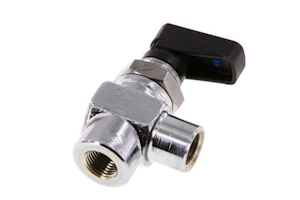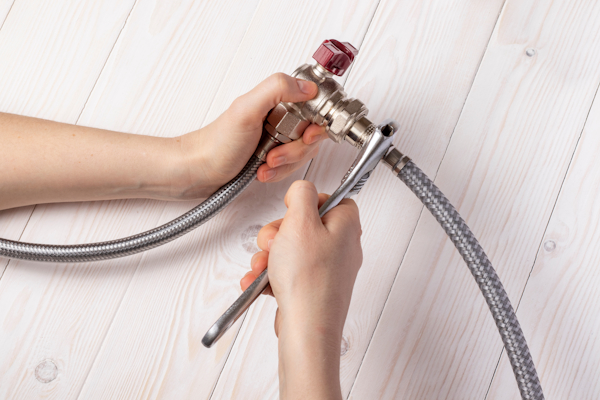90 Degree Ball Valves - Types & Installation

Figure 1: A brass right angle ball valve
90 degree ball valves are angle stop valves most commonly used for connecting residential and commercial water and gas supply lines to fixtures perpendicularly to the supply. They offer quick shutoff and isolation to the water flowing to the fixture in case of maintenance, replacement, or emergency. Their 90° flow path design allows the perpendicular connection between water supply lines and fixtures. This article covers these angle stop valves and how they are used in residential and commercial systems.
Ball valves are quarter-turn valves, meaning the handle needs to be turned 90° to open or close the valve fully. The valve can be easily and quickly closed in the case of an emergency (e.g., pipe rupture).
Table of contents
View our online selection of right angle ball valves!
90 degree ball valve applications
90 degree ball valves, also called right angle ball valves, are typically used throughout residential and commercial plumbing systems. Fixtures are installed perpendicular to the water supply pipes, making angle stop valves necessary. The valve's primary role is to isolate water fixtures from the water supply so work can be done on the fixture (e.g., maintenance and replacement).
Gas applications
Right angle gas ball valves have DVGW gas approval, meaning they can operate with neutral gas, city gas, and liquid gas up to 5 bar (72 psi). These valves are often conveniently identified with a yellow handle and have brass bodies with PTFE or NBR seals.
Note: The maximum pressure limit of 5 bar is specifically for liquid gas. Gas approved 90 degree ball valves can operate at higher pressures (e.g., 40 bar or 580 psi) with other gas phases or media.

Figure 2: An angle ball valve connecting water flexible hoses
Materials
Brass is a common body material for 90 degree ball valves since anything more robust, such as stainless steel, is typically unnecessary for residential and commercial plumbing applications. Teflon or PA/NBR seals ensure the valve will function optimally. Read our chemical resistance guide to learn more about these seal types.
Installation guidelines
Use the following guidelines to assist in installing a 90 degree ball valve.
-
Valve location: In residential and commercial systems, right angle ball valves should be installed where water pipes come out of walls to connect with fixtures. Typically, these valves are found under sinks, behind toilets, and at the water supply for washing machines.
- Accessibility: When choosing the installation location, ensure that the valve will be easily accessible in case of an emergency.
- Installation instructions: The instructions for installing a 90 degree ball valve vary depending on the type of valve and where it will be used. Before selecting a valve, understand the installation requirements to ensure they are feasible for the application.
- Local codes: Check with and understand local regulations around installing angle stop valves. While the process may seem simple, sometimes local regulations can complicate matters.
FAQs
What is a right angle ball valve?
A right angle ball valve is a valve that connects water supply lines to fixtures at a 90° angle, allowing quick shutoff and isolation for maintenance or emergencies.
How does a right angle gas ball valve work?
A right angle gas ball valve controls gas flow by rotating a ball with a bore, aligning it with the flow path for open or perpendicular for closed.
What are the benefits of a 90 degree ball valve?
The benefits of a 90 degree ball valve include easy installation, quick shutoff, space-saving design, and reliable isolation of water or gas flow.
How do you install a right angle ball valve?
To install a right angle ball valve, align it with the supply line, secure it with fittings, ensure the handle is accessible, and test for leaks.





